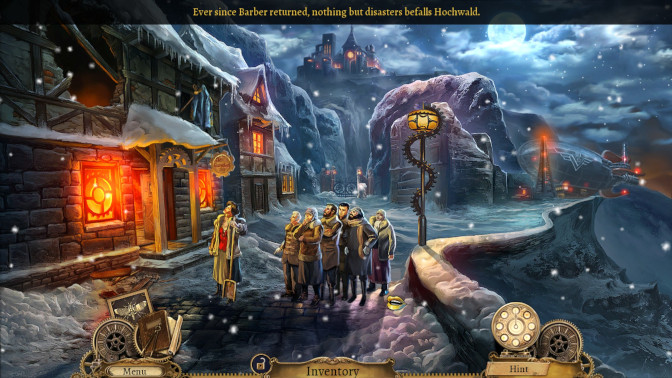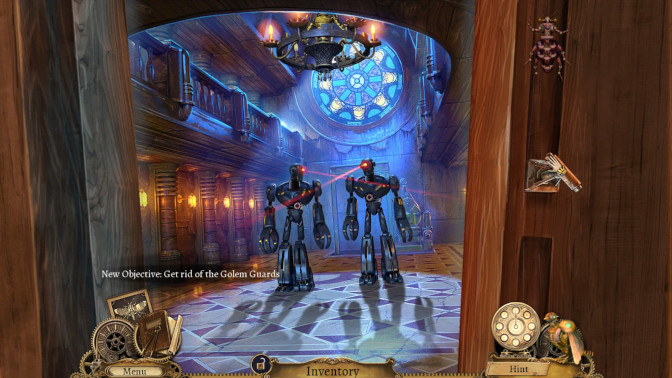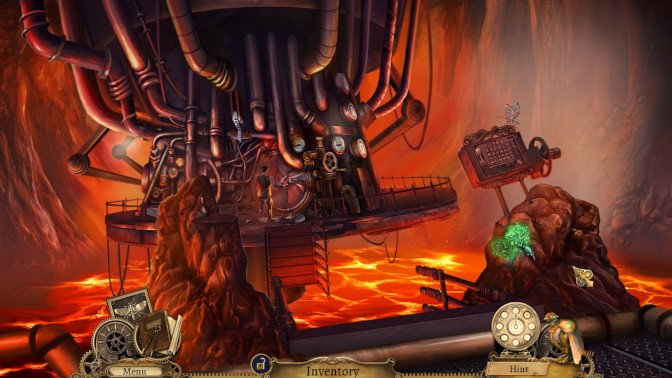|
Clockwork Tales: Of Glass and Ink (Collector's Edition)
Year Published: 2013
Publisher: Artifex Mundi
Developer: Artifex Mundi
|
Clockwork Tales: Of Glass and Ink is the kind of hidden object game that makes you wish it was more than what it is. What there is of it is very well done, but even with a bonus chapter and by HOG standards, it's too short and easy. That may be due to it being an unofficial adaptation of sorts of a series of Polish children's books from the 1940's by Jan Brzechwa. The target audience may have been younger than usual.

Barber's not the most popular guy in town, it seems.
In the Pan Kleks books the game borrows from, Ambrose Ink is apparently the headmaster of a magic school for boys, but in Clockwork Tales he is more of a scientist who has been tracking a series of earthquakes to their source in Hochwald, a hamlet nestled in snow-covered mountains in what appears to be Switzerland near the border of Germany. He summons his friend, Secret Agent Evangeline Glass, to help his investigation, and I could be wrong, but it seems this character was created for the game. Matthew, originally a blackbird, is now a mechanical golden crow - an invention of Ambrose Ink that becomes Evangeline's helper character as he is capable of flying to out-of-reach objects or tangling with evil robotic centipedes.
Evangeline no sooner meets up with Professor Ink when a giant robot busts through the wall of their hotel room and kidnaps him. He is carried off to the nearby Barber Castle, which is ruled by the "General Engineer of Gottland", Barber - a pastiche of Kaiser Wilhelm II and Adolf Hitler with Dr. Strangelove's mechanical arm. Barber and his men use zeppelins for transportation, wear storm trooper helmets and uniforms, and shout various lines in German, though speak most in English with German accents. The inspiration for the villains is clear, even though (judging by Ink's birthdate) the game takes place in the 1850's. It's probably no surprise that Evangeline's quest to save Professor Ink will also lead her to the source of the mysterious quakes.

Two "Iron Giants" and a chandelier positioned conveniently above them.
That is mostly what Clockwork Tales has going for it - a unique Steampunk setting, memorable characters (especially Barber's towering "Iron Giant"-style robots), and gorgeous hand-drawn scenery (although the peculiar way the characters' heads bulge and contort when they talk tells me that even by 2013, HOG developers still hadn't quite figured out how to animate them). The rest of the game is extraordinarily typical hidden object fare, which means it's fun for about 3 hours, and then it's time to move on.
The puzzles are (mostly) fairly simple and fall into the category of "been done many times before", but in Clockwork Tales, redundancy was taken a step farther - two puzzles from Artifex Mundi's earlier title, Abyss: The Wraiths of Eden were transplanted directly into it. I'm not talking about slightly different takes on the same basic puzzle, I mean that it's literally the exact same screen, graphics, solution, and all, right from the other game. (For the curious, they're the sewer cap puzzle and the one where you make shapes by connecting tubes to a switchboard.)

Now this is an Infernal Machine.
Clockwork Tales reminds me of Artifex Mundi's Eventide: Slavic Fable in that both are fun and gorgeous for the short time they last, and both are perhaps better suited to children than adult players. They're not regrettable choices, you'll just wish there was more. But Eventide got two sequels. The developers of Clockwork Tales are not interested in making any at this time. My guess is that it might be related to the character copyright issues or maybe it just didn't sell well enough to justify one.
SCORE: 3/5
|





